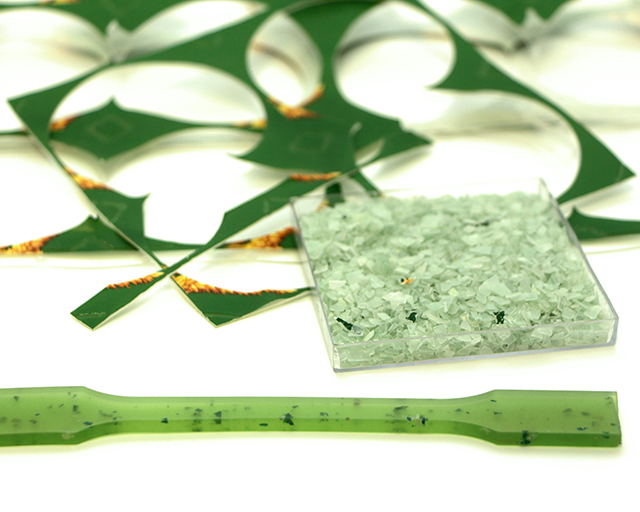Mechanical recycling
A very good possibility for re-introducing homogeneous, process-accrued residues or post-consumer waste into the original or new process is mechanical recycling. The entire composite material is hereby re-used in its original composition. At the HOFZET, we recycle both non-reinforced and short-, long- and continuous-fiber-reinforced plastics by first crushing and then re-using them in, amongst others, the processes listed below
In the case of materials with a thermoplastic matrix, the ground material can be processed via extrusion and, if necessary, additives can be applied to enable a particular application. The regranulate can be processed to form new components, for example through injection molding. Depending on the process control, the fibers contained in the recycled material are shortened to differing degrees and damaged by, amongst other things, the grinding step. Depending on the resulting properties, they can nonetheless still be applied as a reinforcing component or filler material. We offer you preparation, process optimization and material optimization from a single source and thereby enable ecologically and economically attractive applications for recyclates. Ground material with thermosetting matrix cannot be melted again but can be used as a filler material for various thermoplastic and thermosetting matrices.
We place a particular focus upon the investigation and optimization of the grinding process as well as the subsequent ensuing processing options. Aspects such as the brittleness of the materials - which can be increased by reducing the temperature during the grinding process - and the size and quality of the ground material are hereby of particular interest. The subsequent fractionation of the ground material enables high-quality further processing in the extrusion. Depending on the properties of the ground material and the individual application, we implement a customized extrusion process and, if necessary, a suitable additive. Following optimization of the process parameters, the recyclates can be used in high-quality application areas.
Through a holistic approach and the optimization of all the individual steps and parameters, we thereby enable a closed-loop material cycle.
Feedstock recycling
One alternative to mechanical recycling is feedstock recycling. For this, the materials are dismantled into individual components before they are further processed. Non-homogeneous materials can hereby also be recycled. At the HOFZET, we are investigating chemical recycling and pyrolysis in this area.
In chemical recycling, the matrix is dissolved in a solvent. This method enables the utilization of both thermoplastic and thermosetting matrices. Thermoplastic materials are subsequently further processed by removing the applied solvent and processing the remaining material via extrusion to form regranulate. For the dissolution of thermoset matrix materials, for example, the resultant solution is fed back into the production process of materials where it is used to impregnate dry semi-finished products from which laminar components can again be produced.
A further form of feedstock recycling is pyrolysis. For this, the materials which are to be re-utilized are subjected to high temperatures under exclusion of oxygen, as a result of which organic bonds are opened and the majority of the constituents pass into the gaseous or liquid phase and only carbon and mineral components remain as solids. If carbon fiber-reinforced materials are processed in this way, very high-quality recyclate carbon fibers can be recovered. When natural fiber-reinforced plastics are applied, a pyrolysis carbon is obtained as recyclate; this is re-used as, amongst other things, filler material. We test the various pyrolysis products (solids, pyrolysis water and pyrolysis gases) for you in order to ensure applications which are as high-quality and sustainable as possible.
 Fraunhofer Institute for Wood Research
Fraunhofer Institute for Wood Research 
